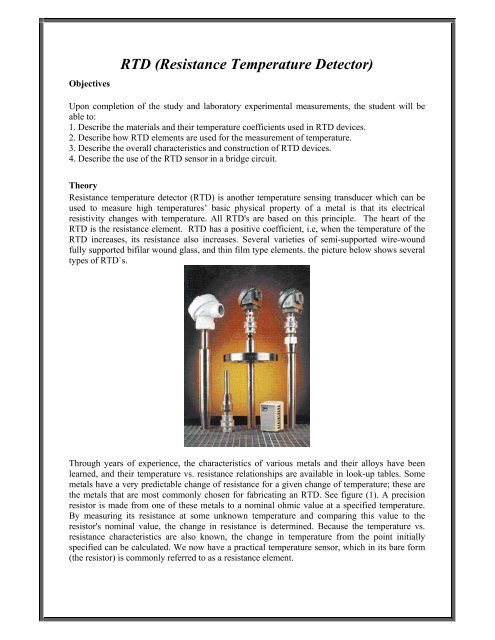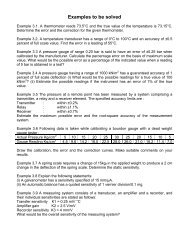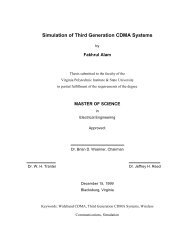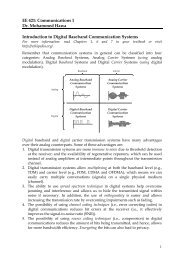Measurement Lab. Resistance Temperature Detector (RTD) - FET
Measurement Lab. Resistance Temperature Detector (RTD) - FET
Measurement Lab. Resistance Temperature Detector (RTD) - FET
You also want an ePaper? Increase the reach of your titles
YUMPU automatically turns print PDFs into web optimized ePapers that Google loves.
Objectives<strong>RTD</strong> (<strong>Resistance</strong> <strong>Temperature</strong> <strong>Detector</strong>)Upon completion of the study and laboratory experimental measurements, the student will beable to:1. Describe the materials and their temperature coefficients used in <strong>RTD</strong> devices.2. Describe how <strong>RTD</strong> elements are used for the measurement of temperature.3. Describe the overall characteristics and construction of <strong>RTD</strong> devices.4. Describe the use of the <strong>RTD</strong> sensor in a bridge circuit.Theory<strong>Resistance</strong> temperature detector (<strong>RTD</strong>) is another temperature sensing transducer which can beused to measure high temperatures’ basic physical property of a metal is that its electricalresistivity changes with temperature. All <strong>RTD</strong>'s are based on this principle. The heart of the<strong>RTD</strong> is the resistance element. <strong>RTD</strong> has a positive coefficient, i.e, when the temperature of the<strong>RTD</strong> increases, its resistance also increases. Several varieties of semi-supported wire-woundfully supported bifilar wound glass, and thin film type elements. the picture below shows severaltypes of <strong>RTD</strong>`s.Through years of experience, the characteristics of various metals and their alloys have beenlearned, and their temperature vs. resistance relationships are available in look-up tables. Somemetals have a very predictable change of resistance for a given change of temperature; these arethe metals that are most commonly chosen for fabricating an <strong>RTD</strong>. See figure (1). A precisionresistor is made from one of these metals to a nominal ohmic value at a specified temperature.By measuring its resistance at some unknown temperature and comparing this value to theresistor's nominal value, the change in resistance is determined. Because the temperature vs.resistance characteristics are also known, the change in temperature from the point initiallyspecified can be calculated. We now have a practical temperature sensor, which in its bare form(the resistor) is commonly referred to as a resistance element.
















